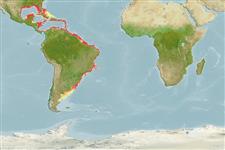Preferred temperature (Ref.
115969): 22.5 - 27.7, mean 25.5 (based on 280 cells).
Phylogenetic diversity index (Ref.
82804): PD
50 = 0.5000 [Uniqueness, from 0.5 = low to 2.0 = high].
Bayesian length-weight: a=0.01047 (0.00905 - 0.01211), b=2.95 (2.92 - 2.98), in cm Total Length, based on LWR estimates for this species (Ref.
93245).
Trophic level (Ref.
69278): 2.0 ±0.00 se; based on food items.
Resilience (Ref.
120179): Medium, minimum population doubling time 1.4 - 4.4 years (K=0.11-0.24; assuming tm=2-3).
Prior r = 0.33, 95% CL = 0.22 - 0.50, Based on 7 data-limited stock assessments.
Fishing Vulnerability (Ref.
59153): Moderate vulnerability (37 of 100).
Climate Vulnerability (Ref.
125649): High vulnerability (57 of 100).
